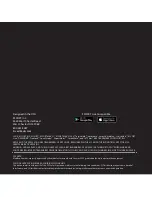
FR146
•
18
TESTING, ALIGNMENT AND ADJUSTMENT
To prepare the FR146 FM VHF Receiver for reliable monitoring operation, you
will need these basic tools:
❒
1. A useful VHF signal source.
❒
2. Hexagonal, non-metallic coil slug alignment tool for L3.
❒
3. Small screwdriver to adjust L4.
1. Signal source:
This signal can be from your test bench equipment or from a
"live" source such as a local repeater. The "live" signals are best for fine-tuning,
but they also have that VHF communications character of being fast and to the
point. Good test bench signal sources include your own 2-meter tranceiver, if
you are licensed to use it, a signal generator or grid-dip oscillator. If you do not
have a steady test signal source for the band within 135-175 MHz of primary
interest to you, and still wish to verify immediately the proper operation of your
FR146, a good and steady VHF signal source will be your local NOAA Weather
Service station, broadcasting around 160 MHz. Once you have verified reliable
reception of your regional NOAA station, adjustment to your desired listening
range will become easier.
2. L3 Alignment Tool:
If you do not already have a set of plastic or nylon coil
alignment tools and do expect to try further Ham radio or electronic hobby
projects, such tools are worth having and can be found inexpensively at any
electronics store including Radio Shack. While a metal Hex key wrench can fit
the coil slug, the metal itself would damage the coil inductance drastically and
therefore should not be used. With patience and sandpaper, a useable tool
might be formed from a wood or plastic rod.
ALIGNMENT PROCEDURE
❒
1. Make sure the power switch is off.
❒
2. Connect the antenna, earphone or speaker and battery.
❒
3. Turn the slug of L3 until it is even with the top of the coil form.
❒
4. Now, turn the slug of L3 clockwise 7 turns back into the form.
❒
5. Turn the slug of L4 until it is flush with the top of the coil and then turn it 2
turns back into the coil.
❒
6. Turn all three controls to the left, fully counterclockwise.
❒
7. Turn the power ON.
❒
8. Turn R2 (Volume control) until you hear some noise.
❒
9. Adjust L4 for maximum noise from the speaker.
Summary of Contents for FR146
Page 8: ...FR146 8 U2 3359 FR146 BLOCK DIAGRAM U1 SA602 MIXER...
Page 9: ...FR146 9 FR146 PARTS LAYOUT DIAGRAM...
Page 12: ...FR146 12...
Page 13: ...FR146 13...







































